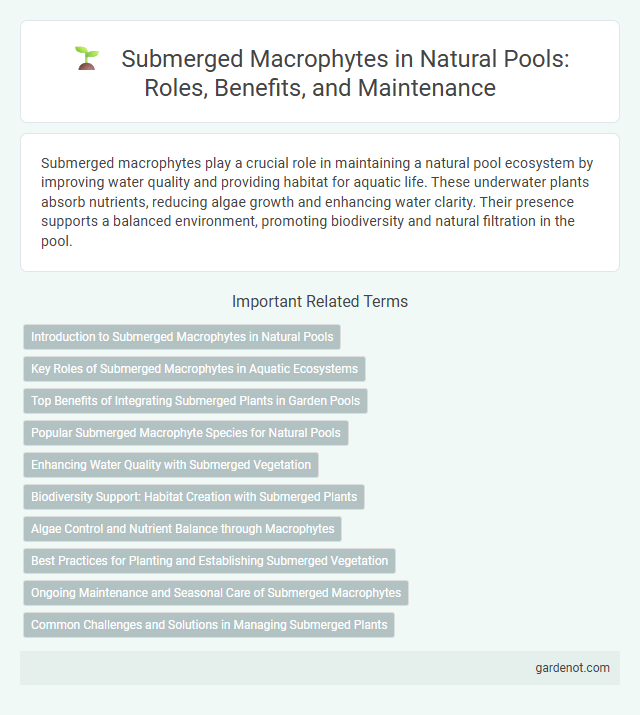Submerged macrophytes play a crucial role in maintaining a natural pool ecosystem by improving water quality and providing habitat for aquatic life. These underwater plants absorb nutrients, reducing algae growth and enhancing water clarity. Their presence supports a balanced environment, promoting biodiversity and natural filtration in the pool.
Introduction to Submerged Macrophytes in Natural Pools
Submerged macrophytes are aquatic plants that grow entirely underwater, playing a crucial role in natural pools by improving water quality through oxygenation and nutrient uptake. These plants provide essential habitat and food sources for aquatic fauna, enhancing biodiversity and ecological balance. Their presence helps stabilize sediment, reduce algae growth, and maintain clear, healthy water conditions in natural pool ecosystems.
Key Roles of Submerged Macrophytes in Aquatic Ecosystems
Submerged macrophytes play a crucial role in natural pools by enhancing water clarity through nutrient uptake and sediment stabilization. They provide essential habitat and breeding grounds for aquatic organisms, contributing to biodiversity and ecosystem health. These plants also help oxygenate the water, supporting aquatic life and maintaining balanced ecosystem functions.
Top Benefits of Integrating Submerged Plants in Garden Pools
Submerged macrophytes enhance natural pool ecosystems by improving water clarity through nutrient absorption and oxygen production, which supports beneficial microbial activity. These plants contribute to the biological filtration process, reducing algae growth and minimizing the need for chemical treatments. Their root systems stabilize sediments, preventing water turbidity and promoting a balanced aquatic environment for diverse wildlife.
Popular Submerged Macrophyte Species for Natural Pools
Popular submerged macrophyte species for natural pools include Elodea canadensis, Ceratophyllum demersum, and Myriophyllum spicatum, known for their ability to oxygenate water and suppress algae growth. These aquatic plants enhance water clarity by absorbing excess nutrients and providing habitat for beneficial microorganisms. Selection of species depends on climate, pool size, and desired ecological balance to maintain a self-sustaining natural pool ecosystem.
Enhancing Water Quality with Submerged Vegetation
Submerged macrophytes play a crucial role in enhancing water quality in natural pools by absorbing excess nutrients such as nitrogen and phosphorus, which helps prevent algal blooms. These aquatic plants improve oxygen levels through photosynthesis, promoting a balanced and healthy aquatic ecosystem. Their root systems also stabilize sediments, reducing turbidity and maintaining water clarity essential for natural pool aesthetics and ecological function.
Biodiversity Support: Habitat Creation with Submerged Plants
Submerged macrophytes create essential habitats within natural pools by providing shelter and breeding grounds for aquatic invertebrates and fish species. These plants enhance biodiversity by supporting complex food webs and improving water quality through nutrient uptake. Their presence fosters a balanced ecosystem, attracting diverse wildlife and promoting habitat stability.
Algae Control and Nutrient Balance through Macrophytes
Submerged macrophytes play a crucial role in natural pool ecosystems by effectively controlling algae growth through nutrient uptake and competition. These aquatic plants absorb excess nitrogen and phosphorus, which are primary nutrients that fuel algal blooms, thereby maintaining a balanced nutrient cycle. Their presence enhances water clarity and supports biodiversity by stabilizing sediments and providing habitat for aquatic organisms.
Best Practices for Planting and Establishing Submerged Vegetation
Submerged macrophytes play a crucial role in maintaining water quality and ecosystem balance in natural pools by oxygenating water and providing habitat for aquatic organisms. Best practices for planting involve selecting native species suited to local conditions, planting in nutrient-rich sediment zones, and spacing plants adequately to prevent overcrowding and ensure healthy growth. Establishing submerged vegetation requires initial protection from strong currents and herbivory, along with regular monitoring to manage algal competition and optimize light penetration for photosynthesis.
Ongoing Maintenance and Seasonal Care of Submerged Macrophytes
Submerged macrophytes require regular monitoring to prevent overgrowth and ensure water clarity in natural pools. Seasonal care involves trimming dead or decaying plants during autumn to reduce nutrient buildup and promote healthy regrowth in spring. Maintaining balanced nutrient levels and oxygenation is crucial for sustaining submerged macrophyte health and supporting aquatic biodiversity.
Common Challenges and Solutions in Managing Submerged Plants
Managing submerged macrophytes in natural pools presents challenges such as excessive growth leading to oxygen depletion, clogged water flow, and habitat disruption. Effective solutions include controlled harvesting, introduction of herbivorous fish species, and maintaining balanced nutrient levels to prevent eutrophication. Mechanical removal combined with regular monitoring ensures sustainable growth while preserving water quality and aquatic biodiversity.
Submerged macrophyte Infographic

 gardenot.com
gardenot.com